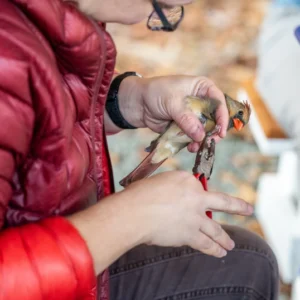January Calendar Image: The Mountain Bluebird
The Mountain Bluebird (Sialia currucoides), which is largely found on the west coast of North America, can be easily recognized by its beautiful sky-blue colour. Although this deep blue colour is only found in males, the females, which are mostly grey-brown, also have a tinge of pale blue on their wings and tail.
Both male and female Mountain Bluebirds tend to be a similar size, somewhere between a House Sparrow and an American Robin, about 16 to 20 cm in length, weighing approximately 30 g.
The habitat of the Mountain Bluebird varies between breeding and nonbreeding seasons. During their breeding season, these little birds prefer open areas of short grasses, shrubs, and trees. This range extends from Alaska to the North-western United States and east towards Manitoba. As a migratory bird, the Mountain Bluebird will travel south for the winter, sometimes travelling as far south as central Mexico.
When these birds are in breeding season, the males will seek out nest cavities, and the females will choose the best one. Although, due to human interest in these animals, there is a preferred attraction to nest boxes making this species vulnerable to human associated hazards. Due to this, little is known about natural nest cavities as most research has been focused on human made nest boxes. Once a male has settled on a nesting site, he will sometimes mime the act of bringing in nesting material to attract a potential female to inspect the site. Once the female has accepted the site, she will then begin to gather and build the nest out of dry grass and other vegetation. A usual clutch size for these birds is about 4 to 8 eggs.
Like many other bluebirds, the Mountain Bluebird will forage from perches. However, they are also excellent aerial foragers and will hover (similar to kestrels and hawks) before dropping onto their prey. This hovering technique is usually only used when food is scarce as it takes up more energy than hunting from a perch.
In the late 19th and early 20th century, this species benefited from the increased forest clearings as it opened up new habitats for foraging and nesting cavities. However, as more settlers arrived, more habitat was destroyed, leading to a decline in the population. Naturalists were afraid that the Bluebirds would become extinct, therefore, bird boxes were made in an attempt to repopulate the species. Luckily, the Mountain Bluebird is of a Low Concern conservation status. However, there are still certain populations where decline can be observed. Areas where trees are too small to provide sufficient nesting cavities and where forest management are reducing available nesting sites are one of the bigger problems. As well as, there is competition between other bluebird species, House Sparrows, European Starlings, and House Wrens for the nest boxes and nest cavities.
These are a species that bird lovers will most certainly try to protect. Their bright colour and beautiful song are only two of the many reasons that make this bird so special!



